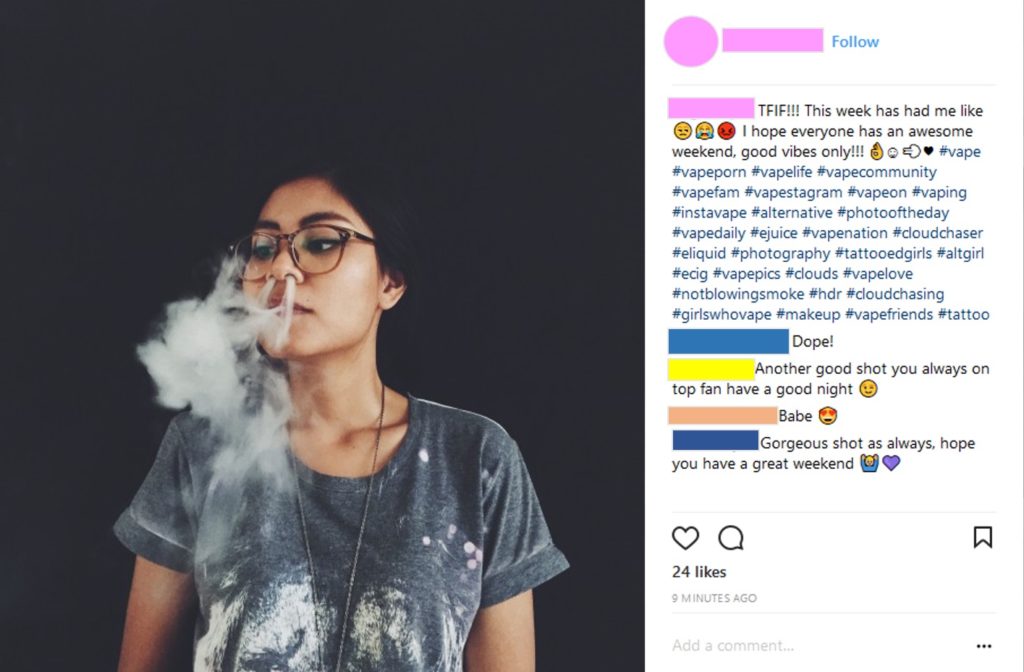Social media posts may make teens more susceptible to vaping, new Stanford research has shown.
The finding, published recently in Nicotine & Tobacco Research, comes from the first study to use a cause-and-effect design to test how social media posts can influence teens' interest in vaping and e-cigarettes. After teens viewed Instagram-style posts, some of which promoted vaping, the researchers asked about their intentions to vape. Participants who had seen more vaping-related posts said they were more likely to use e-cigarettes in the future.
"We found that even just a very short viewing of Instagram posts had an effect on teens," said the study's lead author, Stanford postdoctoral scholar Erin Vogel, PhD. "My concern is that if they're seeing posts about vaping all the time, that could have a really meaningful impact." Vogel and her Stanford colleagues collaborated with scientists at the University of California, San Francisco.

The study also asked teens about their habitual social media use, and found that those who used social media more intensely were more willing to try vaping. The scientists' assessment of intense social-media use included such factors as checking social media accounts when bored, using social media at the expense of other obligations or instead of sleeping, and feeling obligated to keep social accounts updated.
Advertising of combustible cigarettes is prohibited by law in traditional media outlets such as magazines, newspapers and television. But vaping-related posts on social media are largely unregulated, with individual platforms making different decisions about what to allow. For instance, Instagram does not permit e-cigarette and vape manufacturers to pay for 'promoted' posts about their products, but these companies can pay influencers to post laudatory content.
In the study, Vogel and her colleagues recruited 135 teenagers, aged 13 to 18, and divided them into four groups. Participants in each group saw six Instagram-style posts, each featuring a photo and text.
The groups varied according to what type of posts were viewed (low vs. high numbers of e-cigarette/vaping posts) and who supposedly generated the posts (companies vs. other teens).
After participants saw the posts, the researchers asked several questions about their opinions of vaping. For instance, teens were asked to rate on a numerical scale how likely they were to use an e-cigarette soon. Teens who had seen more vaping posts said they were more likely to do so, and those who had seen more advertising (vs. posts from peers) were also more likely. Teens who had seen more vaping posts also had more positive opinions of vaping in general.
Although the effects were modest in size, the differences between groups were statistically significant.
"Seeing any statistically significant effect is notable and suggests we need to do more research on the types of posts kids see all the time, as well as the extent of their exposure," Vogel said.
Vogel noted that the relationship between high levels of habitual social media use and intentions to vape has been observed by other scientists and has more than one possible explanation. Spending more time on social media may make vaping seem more normal. However, it is also possible that other factors, such as struggling with depression, may make teens more vulnerable to both excessive social media use and to willingness to try nicotine.
The researchers hope the findings will lead to tighter regulation of how e-cigarettes can be promoted to youth.
"Social media platforms need to do more to close the loopholes in their policies that allow influencers to promote tobacco products," Vogel said. "And the government hasn't taken steps to ban e-cigarette ads on social media the way they have with other channels. That could happen in the future."
Photo by Sherise






